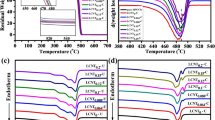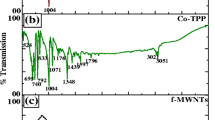Abstract
Novel multiwalled carbon nanotube graft polyethylene glycol-block-polystyrene copolymer nanohybrids (MWCNTs-g-PEG-b-PS) were prepared via atom transfer radical polymerization using carboxylated MWCNTs (MWCNTs–COOH) as a conductive carrier. The chemical structure and the compositions of graft copolymer nanohybrids were characterized by Fourier transform infrared spectroscopy, Raman spectroscopy, thermogravimetry, and gas chromatography, and the morphologies and dispersion behavior were observed by ultraviolet visible spectrophotometer, scanning electron microscope, and transmission electron microscope etc. The MWCNTs-g-PEG-b-PS-grafted copolymer nanohybrids were fabricated into conductive composite thin film sensors to investigate their responsiveness to benzene vapor. The influence of the molecular weights or compositional ratios of PEG and PS blocks on the conductivity of the conducting polymer nanohybrids and responsibility towards benzene vapor was investigated. The conducting polymer nanohybrid film sensors were demonstrated to possess the characteristics of quick response and good restorability, repeatability, and stability.











Similar content being viewed by others
References
Pang H, Xu L, Yan DX, Li ZM (2014) Conductive polymer composites with segregated structures. Prog Polym Sci 39:1908–1933
Ma LF, Bao RY, Huang SL, Liu ZY, Yang W, Xie BH, Yang MB (2013) Electrical properties and morphology of carbon black filled PP/EPDM blends: effect of selective distribution of fillers induced by dynamic vulcanization. J Mater Sci 48:4942–4951. doi:10.1007/s10853-013-7275-z
Deng H, Lin L, Ji MZ, Zhang SM, Yang MB, Fu Q (2014) Progress on the morphological control of conductive network in conductive polymer composites and the use as electroactive multifunctional materials. Prog Polym Sci 39:627–655
Zribi K, Feller JF, Elleuch K, Bourmaud A, Elleuch B (2006) Conductive polymer composites obtained from recycled poly(carbonate) and rubber blends for heating and sensing applications. Polym Adv Technol 17:727–731
Kumar B, Castro M, Fell JF (2012) Tailoring the chemo-resistive response of self-assembled polysaccharide-CNT sensors by chain conformation at tunnel junctions. Carbon 50:3627–3634
Villmow T, Pegel S, John A, Rentenberger R, Pötschke P (2011) Liquid sensing: smart polymer/CNT composites. Mater Today 14:340–345
Tang CY, Long GC, Hu X, Wong KW, Lau WM, Fan MK, Mei J, Xu T, Wang B, Hui D (2015) Conductive polymer nanocomposites with hierarchical multi-scale-structure via self-assembling carbon-nanotubes on grapheme on polymer-microspheres. Nanoscale 6:7877–7888. doi:10.1039/C3NR06056J
Tiusanen J, Vlasveld D, Vuorinen J (2012) Review on the effects of injection moulding parameters on the electrical resistivity of carbon nanotube filled polymer parts. Compos Sci Technol 72:1741–1752
Mechrez G, Suckeveriene RY, Zelikman E, Rosen J, Ariel-Sternberg N, Cohen R, Narkis M, Segal E (2012) Highly-tunable polymer/carbon nanotubes systems: preserving dispersion architecture in solid composites via rapid microfiltration. ACS Macro Lett 1:848–852
Zhang MQ, Rong MZ, Chen SG (2007) Conductive polymer composites serving as gas sensors. Key Eng Mater 334–335:561–564
Sartore L, Sassi A, Barbaglio M (2011) Properties of multifunctional polymers-carbon black composite vapor detectors. Chem Chem Technol 5:67–74
Mangu R, Rajaputra S, Singh VP (2011) MWCNT-polymer composites as highly sensitive and selective room temperature gas sensors. Nanotechnology 22:215502–215508
Smith Martyn T (2010) Advances in understanding benzene health effects and susceptibility. Ann Rev Public Health 31:133–148
Huff J (2007) Benzene-induced cancers: abridged history and occupational health impact. Int J Occup Environ Health 13:213–221
Rana SV, Verma Y (2005) Biochemical toxicity of benzene. J Environ Biol 26:157–168
Villmow T, Kretzschmar B, Potschke P (2010) Influence of screw configuration, residence time, and specific mechanical energy in twin-screw extrusion of polycaprolactone/multi-walled carbon nanotube composites. Compos Sci Technol 70:2045–2055
Spitalsky Z, Tasis D, Papagelis K, Galiotis C (2010) Carbon nanotube-polymer composites: chemistry, processing, mechanical and electrical properties. Prog Polym Sci 35:357–401
Wang HC, Li Y, Yang MJ (2007) Sensors for organic vapor detection based on composites of carbon nanotubes functionalized with polymers. Sens Actuators B 124:360–367
Bilalis P, Katsigiannopoulos D, Avgeropoulos A, Sakellariou G (2014) Non-covalent functionalization of carbon nanotubes with polymers. RSC Adv 4:2911–2934
Braunecker WA, Matyjaszewski K (2007) Controlled/living radical polymerization: features, developments, and perspectives. Prog Polym Sci 32:93–146
Shen J, Champagne MF, Gendron R, Guo S (2012) The development of conductive carbon nanotube networks in polypropylene-based composites during simultaneous biaxial stretching. Eur Polym J 48:930–939
Sahoo NG, Rana S, Cho JW, Li L, Chan SH (2010) Polymer nanocomposites based on functionalized carbon nanotubes. Prog Polym Sci 35:837–867
Shrivastava NK, Khatua BB (2011) Development of electrical conductivity with minimum possible percolation threshold in multi-wall carbon nanotube/polystyrene composites. Carbon 49:4571–4579
Prashantha K, Soulestin J, Lacrampe MF, Claes M, Dupin G, Krawczak P (2008) Multi-walled carbon nanotube filled polypropylene nanocomposites based on masterbatch route: improvement of dispersion and mechanical properties through PP-g-MA addition. Express Polym Lett 2:735–745
Pötschke P, Krause B, Buschhorn ST, Köpke U, Müller MT, Villmow T, Schulte K (2013) Improvement of carbon nanotube dispersion in thermoplastic composites using a three roll mill at elevated temperatures. Compos Sci Technol 74:78–84
Majeed S, Filiz V, Shishatskiy S, Wind J, Abetz C, Abetz V (2012) Pyrene-POSS nanohybrid as a dispersant for carbon nanotubes in solvents of various polarities: its synthesis and application in the preparation of a composite membrane. Nanoscale Res Lett 7:296–306
Crescenzo AD, Ettorre V, Fontana A (2014) Non-covalent and reversible functionalization of carbon nanotubes. Beilstein J Nanotechnol 5:1675–1690
Li JR, Xu JR, Zhang MQ, Rong MZ (2003) Electrical response to organic vapor of conductive composites from amorphous polymer/carbon black prepared by polymerization filling. Macromol Mater Eng 288:103–107
Lala NL, Thavasi V, Ramakrishna S (2009) Preparation of surface adsorbed and impregnated multiwalled carbon nanotube/nylon-6 nanofiber composites and investigation of their gas sensing ability. Sensors 9:86–101
Luo YL, Wang SH, Li ZQ (2008) Characterization, microstructure, and gas sensitive response behavior of PEG/lithium salt polymer electrolyte films. J Mater Sci 43:174–184. doi:10.1007/s10853-007-2125-5
Xu JW, Xu F, Luo YL (2015) Core cross-linked H-type poly(methacrylic acid)-block-hydroxyl terminated polybutadiene-block-poly(methacrylic acid) four-armed star block copolymer micelles for intercellular drug release. J Bioact Comp Polym 30:349–365
Gao C, Vo CD, Jin YZ, Li W, Armes SP (2005) Multihydroxy polymer-functionalized carbon nanotubes: synthesis, derivatization, and metal loading. Macromolecules 38:8634–8648
Sarafraz-Yazdi A, Amiri A, Rounaghi G, Hosseini HE (2011) A novel solid-phase microextraction using coated fiber based sol–gel technique using poly(ethylene glycol) grafted multi-walled carbon nanotubes for determination of benzene, toluene, ethylbenzene and o-xylene in water samples with gas chromatography-flam ionization detector. J Chromatogr A 1218:5757–5764
Wen Y, Wu H, Chen S, Lu Y, Shen H, Jia N (2009) Direct electrochemistry and electrocatalysis of hemoglobin immobilized in poly(ethylene glycol) grafted multi-walled carbon nanotubes. Electrochim Acta 54:7078–7084
Kong H, Gao C, Yan D (2004) Controlled functionalization of multiwalled carbon nanotubes by in situ atom transfer radical polymerization. J Am Chem Soc 126:412–413
Wu HX, Tong R, Qiu XQ, Yang HF, Lin YH, Cai RF, Qian SX (2007) Functionalization of multiwalled carbon nanotubes with polystyrene under atom transfer radical polymerization conditions. Carbon 45:152–159
Ma XT, Zhan HJ (2008) Study of DMF catalytic air epoxidation of styrene under mild conditions. China Surfactant Deterg Cosmet 38:319–321
Wei C, Dai L, Roy A, Tolle TB (2006) Multifunctional chemical vapor sensors of aligned carbon nanotube and polymer composites. J Am Chem Soc 128:1412–1413
Zhang T, Mubeen S, Myung NV, Deshusses MA (2008) Recent progress in carbon nanotube-based gas sensors. Nanotechnology 19:332001–332014
Kar P, Choudhury A (2013) Carboxylic acid functionalized multi-walled carbon nanotube doped polyaniline for chloroform sensors. Sens Actuators B 183:25–33
Shang S, Zeng W, Tao X (2012) Investigation on the electrical response behaviors of multiwalled carbon nanotube/polyurethane composite in organic solvent vapors. Sens Actuators B 166–167:330–337
Acknowledgements
This work is supported by the Natural Science Foundation of China (Grant NSFC 21273142 and 21172138).
Author information
Authors and Affiliations
Corresponding authors
Electronic supplementary material
Below is the link to the electronic supplementary material.
Rights and permissions
About this article
Cite this article
Luo, YL., Bai, RX., Xu, F. et al. Novel multiwalled carbon nanotube grafted with polyethylene glycol-block-polystyrene nanohybrids: ATRP synthesis and detection of benzene vapor. J Mater Sci 51, 1363–1375 (2016). https://doi.org/10.1007/s10853-015-9455-5
Received:
Accepted:
Published:
Issue Date:
DOI: https://doi.org/10.1007/s10853-015-9455-5




